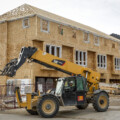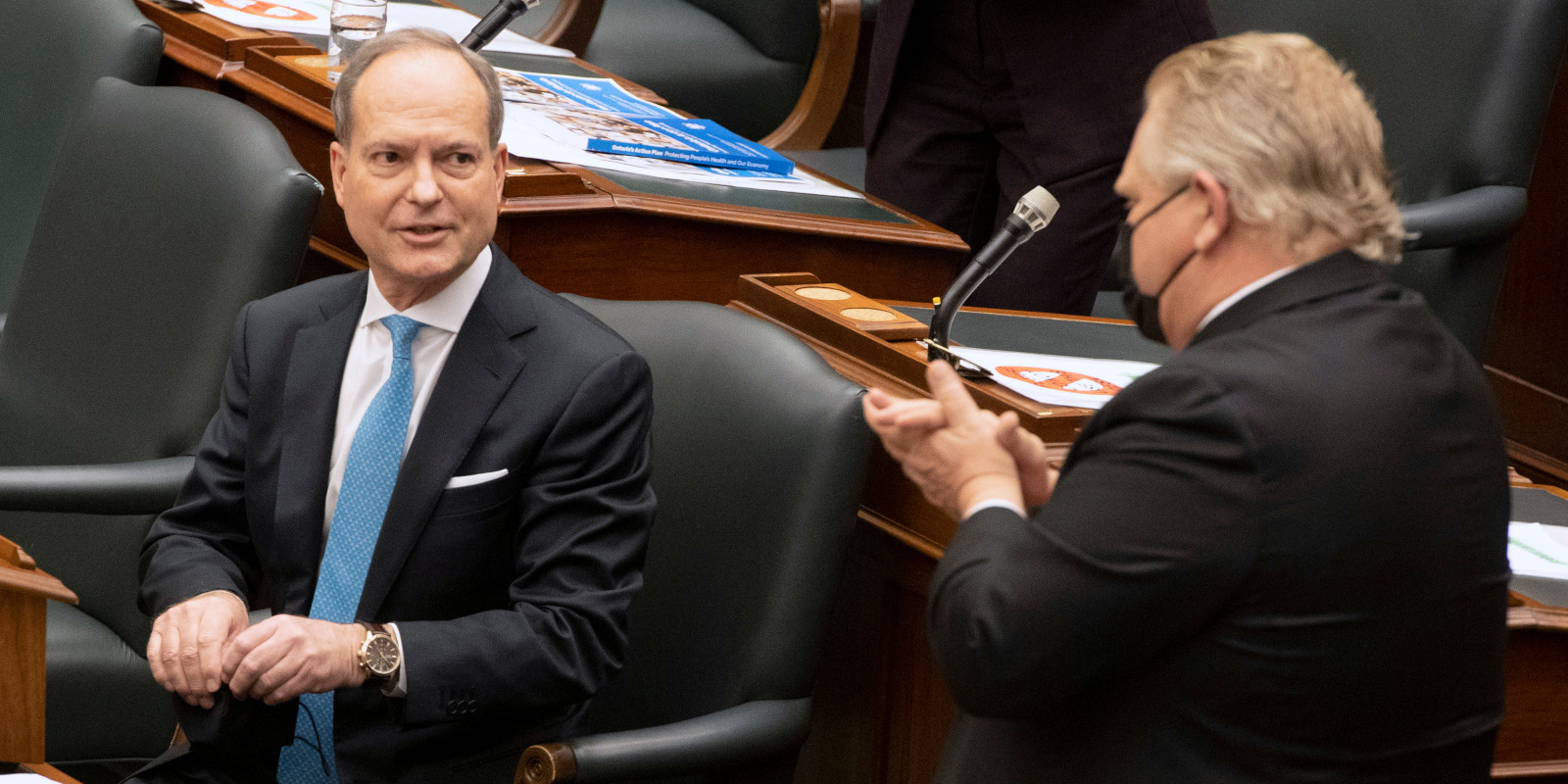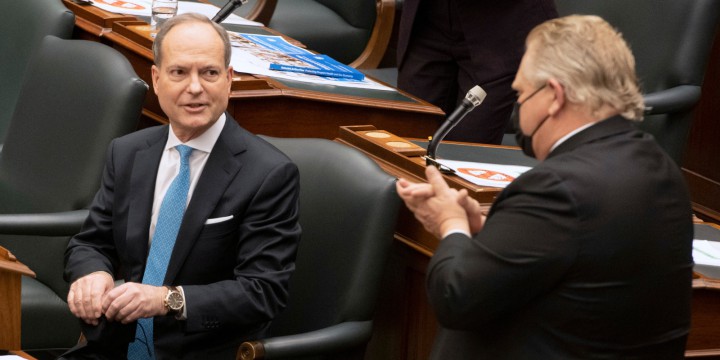Today’s Hub Dialogue is with Ontario Finance Minister Peter Bethlenfalvy. Minister Bethlenfalvy, who held various senior executive positions in the financial sector—including co-president of the credit rating agency DBRS and senior Vice President at Manulife Financial—was first elected in the riding of Pickering-Uxbridge in 2018.
He has served as President of the Treasury Board and now the Minister of Finance in the Ford government and recently tabled the province’s Fall Economic and Fiscal Outlook.
This conversation has been revised and edited for length and clarity.
SEAN SPEER: It’s an honour to speak to Minister Bethlenfalvy about the experience of governing through a once-in-a-lifetime pandemic and his plans to rebuild the Province of Ontario in its aftermath. Thanks for joining us, Minister.
MINISTER PETER BETHLENFALVY: Thanks for having me, Sean.
Infrastructure and investment
SEAN SPEER: Your recent Fall Economic and Fiscal Outlook sets out considerable ambition with regards to public infrastructure in particular and building things in general. While that agenda will resonate with a lot of Ontarians, one question they may have is: how are we going to actually get these projects done?
What in your view, Minister, has held up building things in the province in the past? And what can government do to address these obstacles and in turn help to carry out your plan for unprecedented capital investment across the province?
MINISTER PETER BETHLENFALVY: That’s a great question. To kick things off, there has to be a political will and a vision. I think that’s prerequisite number one, but the fast follow on that is the delivery mechanism. Too often governments have announced big projects, year after year, election after election and they never follow through. We have the vision to build Ontario, and we have a plan to get it done. I think that’s where our government has differentiated itself from previous governments.
It’s one thing to have ambitious plans, but if it takes seven years to get the first shovel in the ground, what are you really achieving? Since being elected we have gone about systematically reforming statutes, regulations, and other policies to cut red tape and accelerate project approvals without undermining health, safety, and the environment.
Making it easier to build and do business in Ontario is core to our government’s vision and agenda. We want the province to be a place where we can build things—where projects can get started and get done.
In concert with that, you have labour participation. We are thinking strategically about what kind of labour force we need not just for today, but for the future. That’s why our government has made skilled trades an unprecedented priority. It’s wonderful to see the progress being made on that file.
The last thing I would point to would be making sure that you’re constantly thinking about the changing landscape. The modernization effort that we’ve pursued here is to be constantly thinking about processes, constantly looking for continuous improvement, constantly looking for how we can execute things better, faster, and cheaper.
I think a good example of that would be acknowledging that there was a shortfall of long-term care beds in this province—not just the absolute number, but the quality of those beds. We campaigned on building 30,000 beds and we started the process to build those beds. Then of course COVID-19 hit. The tragedy of COVID-19 on our long-term care homes is not lost on our government or the people of Ontario.
Within three months, in July 2020, I joined the Premier and the MPP Rod Philips (Ajax) to announce at the site of the Ajax-Pickering Hospital that we would build rapidly 320 new long-term care beds. Shovels went into the ground in December 2020, the building was capped in summer 2021, and it’ll be completed by the end of this year.
That’s a great example of getting something done. Where there’s a will, where you can work across federal, provincial, and municipal governments, there’s a way.
Public spending
SEAN SPEER: I’ve heard you say before, Minister, that you got into elected life because you were concerned about the province’s unsustainable public finances. Yet, since you’ve been elected, you’ve had to steer the province, both as Treasury Board President and now as Minister of Finance, through a massive crisis that’s required unprecedented public spending. What has that been like for you? And how important is it for you to get the provincial budget back on track?
MINISTER PETER BETHLENFALVY: Sean, when you’re confronted with a once-in-a-lifetime crisis, you do whatever it takes. So that’s number one: making sure that no expenses have been spared in the fight against COVID-19. This has come in the form of investing in hospitals and long-term care facilities and a number of areas with short- and long-term benefits. We have kept an eye on protecting the progress we have made in the fight against COVID-19.
At the same time, we recognize that these spending levels aren’t sustainable or desirable in the long run. We have also been focused on how we’re going to come out of this extraordinary experience, which means having an eye on the economic recovery.
I look at the future in terms of defeating COVID-19 and protecting our health care system. But, at the same time, we have to have a plan for the future. Having healthy people leads to a healthy economy. You can’t have one without the other.
I would say that the focus on long-term economic growth has to be on the right conditions for a sustainable economic trajectory, one that can outperform our economic potential in this province. So, we’re focused on things that can contribute to productivity gains. That’s why infrastructure is so critical. These are real assets. They’re long-term productive assets for the province.
When I think about the $400 billion accumulated of provincial debt since Confederation, only one third is for real assets: real assets like infrastructure that will lead to long term productivity gains, by moving people, moving goods, broadband over the internet, hospitals, and long-term care that will take care of people. These are the types of investments that allow Ontario to outperform its potential including, for instance, investing in people, like the skilled trades, that provide a bridge between yesterday’s skills and tomorrow’s skills. There’s a role for government to play in bridging the two.
Social mobility
SEAN SPEER: A lot of Ontarians have gotten to know you in your role as Minister of Finance during this crisis. You’re frequently on television, newspapers, and elsewhere. They may similarly know about your professional career, but they may not know a lot about you personally.
Your personal story is one of an immigrant background and social mobility. How has your personal experience shaped the work that you’ve done as finance minister? And what have you done over the past couple of years to help strengthen the conditions for social mobility in the province, so future generations can climb the economic and social ladder just as you’ve done so in your own life?
MINISTER PETER BETHLENFALVY: Well, that’s a terrific question. Let me just say upfront that social mobility is a very fundamentally important principle that has dictated not only my life in the private sector but also now in the public sector. You’ve really tapped into one of the real motivations for me to get into public service.
My parents came to Canada from Hungary during World War Two. My mom’s family, including her parents and grandparents, my grandparents and great-grandparents, fled here. So I got to know three of my great grandparents who came to Canada and learn about and see their experience. My father didn’t come with his family. He never saw his parents again because the Iron Curtain went up.
My parents came to this country, they met in Ontario where they could find jobs and could work hard, get an education, raise a family, and feel safe in Canada. They had opportunities if they worked hard. That really formed my sort of persona, if you will, at a very young age.
So, the opportunity to give back was important to me. I certainly subscribe to the idea that democracy doesn’t happen by accident, that we all have to contribute to ensuring that opportunity for the next generation of Canadians.
So, how does that manifest itself? Immigration is absolutely critical, not only to your previous question about the finances of the province, or your question about infrastructure and economic growth, but to contributing to a province where people can aspire and thrive. I think immigration is fundamental to that.
I certainly subscribe to the idea that democracy doesn’t happen by accident.
But also, as a government, there’s a role to pursue better ways to have an inclusive economic recovery and create the conditions for people to feel safe. For instance, I think of our Women’s Taskforce which is pursuing questions like: How do we get more women into the workforce? How do women feel in the skilled trades? We need people in the skilled trades, and these are good-paying jobs, so how do we get more women? What are some of the barriers in small businesses?
These are also issues that we’re pursuing in the Second Career program which aims to help people when their skills and experiences may not match the skills needed for tomorrow. Building that bridge between today and tomorrow is something that we can do to help workers. So is putting more money in the pockets of low-income people by raising the minimum wage and having the lowest personal income tax for low-income earners in Canada.
A fair society that leads to more opportunities for Canadians of all backgrounds and leads to greater social mobility is what we must aspire to. Having grown up listening to the stories and seeing the hardships of my family, my parents, in what they had to deal with, and then seeing what Canada provided them, has been a big inspiration for me to get into public life.
Economic growth
SEAN SPEER: If you look beyond COVID-19, what in your view is the biggest challenge facing the province? What’s the long-term issue that occupies your thinking these days?
MINISTER PETER BETHLENFALVY: The number one thing is, how do we continue to build for future economic growth?
I believe that Ontario has all the ingredients to outperform economically relative to other provinces—frankly, relative to North America—and to be the economic engine of Canada as it had been since Confederation. If that’s s the vision, how do you get there?
That’s why I think it’s so important that we continue to invest in talent in this province, and invest in various ways to reskill, to retrain, and retain talent. We’ve got a world-class education system that we’re continuing to foster with increasing investment year after year. We also continue to look at ways to lower costs for businesses to operate in this province. So, whether it’s energy costs or productivity gains through investing in the digital economy, which I think is critical, we need to be focused on building the groundwork for more jobs, better pay, and more opportunity in our province.
Fundamentally, we want to make Ontario the absolute best place to live, work, and raise a family. Not only in the country, but in North America. I believe this is possible. When I think about the future, Sean, I really think that the economics of where you can put food on the table, where you can raise a family, where you can feel safe, and the opportunity is there for everybody regardless of background, gender, faith, and so on. That’s the goal. We aspire to extend opportunity to all the 15 million people of Ontario and those that will make their home here in the future.
SEAN SPEER: Just one final question, Minister Bethlenfalvy. An interesting debate has emerged in the context of COVID-19 about whether we’ll see a permanent change in where people work and live. Will we see a permanent shift to remote work and in turn a flight from the urban downtown which would have implications for peripheral communities and possibly housing prices in the province’s major cities? I’d just be interested to get your perspective on what you think about that debate, and what, if any, implications there will be for government policy.
MINISTER PETER BETHLENFALVY: I think change is part of life, and sometimes it feels like it’s accelerating. The question really is how do we adapt to that change? Is Ontario a place where we can adapt to changing circumstances?
You mentioned remote work, and the hybrid workplace model has potential. The market will drive change. Think of housing, for instance. It is possible that a lot of office space in Toronto will be converted to residential space. I lived in New York for 15 years where I saw the transformation of Manhattan into residential from all offices.
As policymakers, we have to look down the road and say, “Change is going to be there. So, what can we do today to prepare for tomorrow?” That’s why infrastructure, including putting shovels in the ground today, is so important.
I think about electric vehicle production as another area of big change. It’s quite clear that electric vehicles will be the only choice that consumers will have within a number of years. So, what infrastructure do we need to begin to put in place now, with the greater Golden Horseshoe growing in population by a million every five years? Some of those people are going to bike but most will have cars.
It can take 10 years to build a highway. We currently have gridlock in many parts of the GTA. How can we make investments to address gridlock today and prepare for the rise of electric vehicles tomorrow?
That is why our government has put a stake in the ground and announced we are building highway 413 and the Bradford Bypass. We need to build for the future. Tomorrow’s prosperity depends on getting shovels in the ground today.
I think about broadband: we’ve accelerated building broadband and high-speed internet for the province. You don’t have to get much north of my riding of Pickering to get poor broadband quality, if at all, where children will have to compete for the bandwidth for their school courses. So we will accelerate to build that out by 2025. Is that ambitious? Yes. Can we get it done? Absolutely.
That’s how we need to think about change. How can we adapt to change that’s going to be driven tomorrow today?
SEAN SPEER: Well, Minister, thank you for taking the time to speak with us and sharing your insights about provincial policymaking, the provincial economy, and some of these big structural changes occurring in Ontario and elsewhere around the world. I’m honoured to have had the time to speak with you.
MINISTER PETER BETHLENFALVY: I really appreciate you asking me to come on to do this.
Recommended for You

Ginny Roth: J.D. Vance, Pierre Poilievre, and how they slice their economic pie

RCMP spending to protect MPs may have risen 112% since 2018, as Canadian politicians face greater rise in threats

Trevor Tombe: Canadians are paying billions in hidden taxes on new homes

Stephen Staley: Widespread deregulation is Canada’s golden ticket for economic growth



